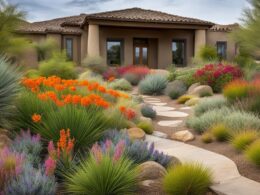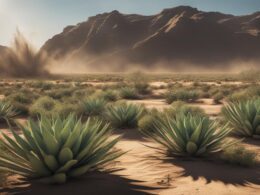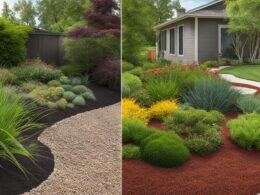Are you looking to enhance your desert landscape with mulch? Choosing the right mulch is essential for promoting healthy plant growth, conserving moisture, and suppressing weeds. In this expert guide, we’ll walk you through everything you need to know about selecting the perfect mulch for your desert garden.
Key Takeaways:
- Choosing the right mulch is crucial for desert landscaping.
- Mulch serves multiple purposes, including soil insulation, moisture retention, weed suppression, and soil enhancement.
- There are various types of mulch available, such as grass clippings, wood or bark chips, compost, straw, and peat moss.
- Proper preparation and application of mulch are essential for optimal results.
- Consider using organic mulch for the best soil enrichment in desert landscapes.
Reasons to Use Mulch
Mulch offers numerous benefits for desert landscapes, making it an essential component of your gardening routine. By incorporating mulch into your landscaping, you can enhance the overall health and appearance of your plants while reducing maintenance requirements. Here are some key reasons why you should consider using mulch:
1. Soil Insulation
Mulch acts as a natural insulator, regulating soil temperatures and protecting plant roots from extreme heat or cold. This is particularly crucial in desert environments where temperature fluctuations can be significant. By keeping the soil insulated, mulch helps maintain optimal conditions for plant growth and development.
2. Moisture Retention
One of the most significant benefits of mulch in desert landscaping is its ability to retain moisture. Mulch acts as a barrier, reducing evaporation and preventing rapid water loss from the soil. This can significantly reduce the frequency of watering, conserving water and saving you time and effort in maintaining your garden. By retaining moisture, mulch also helps plants better withstand drought conditions.
3. Weed Suppression
Another advantage of using mulch is its weed-suppressing properties. Mulch creates a physical barrier that prevents weed seeds from germinating and inhibits their growth. By reducing weed competition, mulch allows your plants to access more nutrients and resources, promoting healthier growth and reducing the need for manual weed removal.
4. Soil Enhancement
Mulch is an excellent source of organic matter for the soil. As it breaks down, mulch releases essential nutrients, enriching the soil and creating a fertile environment for plant growth. This improves soil structure, aeration, and nutrient availability, leading to healthier and more robust plants.
By using mulch in your desert landscape, you can create a more resilient and beautiful garden while minimizing maintenance tasks. The benefits of insulation, moisture retention, weed suppression, and soil enhancement make mulch an invaluable tool for any gardener.
Types of Mulching Materials
Mulching materials play a crucial role in desert landscaping, providing numerous benefits to your garden. Here is a comprehensive list of the types of mulch commonly used in desert landscapes:
- Grass clippings
- Wood or bark chips
- Compost
- Straw
- Peat moss
- Decaying leaves
- Hay
- Decomposed granite
- Gravel or stone
- Rubber
- Tumbled glass
- Landscape fabric
Each mulching material has its own unique characteristics and benefits. Grass clippings and wood or bark chips are popular choices, providing insulation, moisture retention, and weed suppression. Compost and peat moss are excellent options for enhancing the soil with essential nutrients. Alternatively, stones, gravel, and rubber mulch offer a decorative touch to your landscape, reducing water evaporation and preventing weed growth.
Choosing the right mulching material depends on various factors, such as the climate in your area, water availability, and the specific needs of your plants. Consider consulting with a local gardening expert to determine the best mulch for your desert landscape.
Table: Comparison of Mulching Materials
| Mulching Material | Benefits | Considerations |
|---|---|---|
| Grass Clippings | Free and readily available | May contain weed seeds |
| Wood or Bark Chips | Slow decomposition, effective insulation | May attract termites |
| Compost | Improves soil fertility | Requires regular replenishment |
| Straw | Excellent moisture retention | May harbor pests |
| Peat Moss | Enhances soil structure and water retention | Expensive and acidic |
| Decaying Leaves | Rich in organic matter | May become matted and compacted |
| Hay | Effective weed suppression | Potential for weed seed contamination |
| Decomposed Granite | Allows water penetration, prevents weed growth | May be unstable and prone to erosion |
| Gravel or Stone | Durable and decorative | Can trap heat and increase soil temperature |
| Rubber | Long-lasting, reduces weed growth | May leach chemicals into the soil |
| Tumbled Glass | Unique aesthetic appeal | May trap excessive heat |
| Landscape Fabric | Controls weed growth effectively | Requires careful installation for proper drainage |
Remember, the choice of mulching material should align with your landscaping goals and the specific needs of your plants. Whether you prioritize water conservation, weed control, or soil enhancement, there is a mulch option suitable for your desert garden.
Preparation and Application of Mulch
Proper preparation and application of mulch are essential for optimal results in desert landscaping. Before mulching, it is important to clear the area of grass, leaves, and weeds to ensure a clean and healthy foundation for the mulch. This can be done by manually removing the debris or using a rake or leaf blower for larger areas.
Once the area is clear, the mulch can be applied. It is recommended to apply the mulch at a depth of about three inches. This ensures sufficient coverage to provide insulation, moisture retention, and weed suppression. However, be cautious not to pile the mulch too high around the base of plants and tree trunks, as this can lead to rotting and damage. Keep the mulch a few inches away from the plants to allow proper airflow and prevent any potential harm.
Mulching in desert landscapes may require replenishment in spring and fall. It is important to assess the condition of the mulch during these seasons and add new mulch as needed. This replenishment helps maintain the benefits of mulching, such as moisture retention and weed suppression, throughout the year. Regular maintenance and monitoring of the mulch will ensure a healthy and thriving landscape.
Table: Mulching Tips
| Tips | Description |
|---|---|
| Clear the area | Remove grass, leaves, and weeds before mulching. |
| Apply three inches deep | Ensure sufficient coverage for insulation, moisture retention, and weed suppression. |
| Avoid piling around plants | Prevent rotting and damage by keeping the mulch a few inches away from plants and tree trunks. |
| Assess mulch condition | Regularly check the mulch in spring and fall and replenish as needed. |
By following these preparation and application tips, you can maximize the benefits of mulching in your desert landscape. Remember to clear the area, apply the mulch at the recommended depth, and monitor the mulch for replenishment when necessary. With proper mulching, you can create a beautiful and sustainable garden that thrives even in arid conditions.
Organic vs. Inorganic Mulch
When it comes to choosing mulch for your desert landscaping, one important decision you’ll need to make is whether to use organic or inorganic mulch. Both options have their pros and cons, so it’s essential to understand the differences between them.
Organic mulch is made from natural materials such as bark, wood chips, compost, and straw. It provides numerous benefits for your plants and soil. Organic mulch breaks down over time, adding valuable nutrients to the soil and promoting healthier plant growth. It also helps retain moisture, suppresses weed growth, and improves the overall soil structure.
On the other hand, inorganic mulch is made from synthetic materials such as plastic or rubber. While it does offer some benefits, such as long-lasting durability, inorganic mulch lacks the ability to enrich the soil. It doesn’t break down like organic mulch, which means it doesn’t provide the same level of nutrient replenishment.
Using organic mulch is generally considered the preferred choice for desert landscaping. It not only improves the health of your plants but also contributes to long-term soil fertility. Plus, organic mulch blends in seamlessly with the natural environment, adding to the overall aesthetic appeal of your landscape.
Ultimately, the decision between organic and inorganic mulch will depend on your specific preferences and needs. If you prioritize soil enrichment and environmental sustainability, organic mulch is the way to go. However, if you’re looking for a low-maintenance and long-lasting option, inorganic mulch may be more suitable for your desert landscape.
Table: Organic vs. Inorganic Mulch
| Criteria | Organic Mulch | Inorganic Mulch |
|---|---|---|
| Source Material | Natural materials (e.g., bark, wood chips, compost) | Synthetic materials (e.g., plastic, rubber) |
| Soil Enrichment | Yes, adds nutrients to the soil | No, does not contribute to soil fertility |
| Moisture Retention | Yes, helps retain moisture in the soil | Yes, helps retain moisture in the soil |
| Weed Suppression | Yes, helps suppress weed growth | Yes, helps suppress weed growth |
| Longevity | Moderate, breaks down over time and requires replenishment | Long-lasting, does not break down |
| Aesthetic Appeal | Blends in with the natural environment | Mimics natural materials or provides a different aesthetic |
Mulch Comparison: Hardwood vs. Pine Bark vs. Cedar
When it comes to choosing the right mulch for your desert landscaping, three popular options are hardwood mulch, pine bark mulch, and cedar mulch. Each type has its own characteristics and benefits, so let’s compare them to help you make an informed decision.
Hardwood Mulch
Hardwood mulch is made from shredded hardwood trees and is known for its durability and long-lasting nature. It decomposes slowly, which means it will retain its color and texture for a longer period, providing an attractive aesthetic appeal to your garden. This mulch type is ideal for areas where you want a low-maintenance option that requires less frequent replenishment.
Pine Bark Mulch
Pine bark mulch is made from the bark of pine trees and is known for decomposing more quickly than hardwood mulch. This fast decomposition rate allows it to provide more nutrients to the soil, which can benefit the health and growth of your plants. However, it also means that pine bark mulch requires more frequent replenishment to maintain its effectiveness.
Cedar Mulch
Cedar mulch is derived from cedar trees and offers a unique combination of beauty and functionality. It has a pleasant fragrance that can add a refreshing aroma to your garden. However, over time, cedar mulch may fade in color as it decomposes. This mulch type is generally considered a good choice if you’re looking for a visually appealing option and don’t mind the potential color change.
| Mulch Type | Key Features |
|---|---|
| Hardwood Mulch | Durable, long-lasting, retains color |
| Pine Bark Mulch | Fast decomposition, provides more nutrients |
| Cedar Mulch | Pleasant fragrance, visually appealing |
Ultimately, the choice between hardwood mulch, pine bark mulch, and cedar mulch depends on your personal preferences and the specific needs of your landscape. Consider factors such as durability, nutrient enrichment, aesthetics, and maintenance requirements to determine the most suitable option for your desert garden.
The Best Time to Apply Mulch
If you want to maximize the benefits of mulching in your desert landscape, timing is key. Understanding the best time to apply mulch can help ensure the health and beauty of your garden year-round.
Mulching in mid-spring is generally recommended for desert gardens. By this time, the soil has started to warm up, and adding mulch helps to retain moisture, suppress weeds, and regulate soil temperature. Applying mulch in the spring also provides a protective layer for the summer months when temperatures can soar.
Fall is another suitable time for mulching. As the temperatures start to cool down, mulch helps retain moisture in the soil during the winter months. It also acts as insulation for plant roots, protecting them from freezing temperatures.
Factors to Consider
- The specific needs of your plants: Some plants may benefit from mulching at different times of the year, depending on their growth cycles.
- The climate in your area: Consider the average temperatures and precipitation patterns to determine the optimal time for mulching.
- Your watering routine: Mulching can reduce water evaporation, so adjust your watering schedule accordingly after mulching.
Remember that these guidelines are general recommendations, and it’s important to consider the unique characteristics of your garden. Assess the health of your plants and soil regularly to determine if mulch replenishment is needed throughout the year.
| Best Time to Apply Mulch | Benefits |
|---|---|
| Mid-Spring | – Helps retain moisture |
| – Suppresses weed growth | |
| – Regulates soil temperature | |
| Fall | – Retains moisture during winter |
| – Insulates plant roots |

What Type of Mulch is Best for Desert Landscaping?
When it comes to mulching arid climates effectively, using organic materials like straw, wood chips, or pine needles can help retain moisture in the soil and regulate temperature. These types of mulch can also break down over time, adding nutrients to the soil and improving overall soil health in desert landscaping.
Conclusion
Choosing the right mulch for your desert landscaping is crucial for achieving a healthy and beautiful garden. As this expert guide has highlighted, mulch offers several benefits that contribute to the overall success of your landscape.
Mulch acts as a natural weed suppressant, reducing the need for constant maintenance and allowing your plants to thrive. It also retains moisture in the soil, reducing the frequency of watering and ensuring optimal hydration for your plants.
In addition, mulch enhances the soil by adding organic matter, promoting healthier plant growth and providing essential nutrients. By choosing organic mulch over inorganic options, you can enrich your soil and create an environment that fosters plant vitality.
Remember to properly prepare and apply the mulch, ensuring a depth of at least three inches and keeping it a few inches away from plant bases and tree trunks. Regular mulch replenishment in spring and fall will help maintain its effectiveness in your desert landscape.
By following this expert guide on mulch for desert landscaping, you can create a thriving and visually appealing garden that will be the envy of your neighborhood. Make informed choices based on your landscape’s needs, and enjoy the many benefits that mulch provides for your plants and soil.













